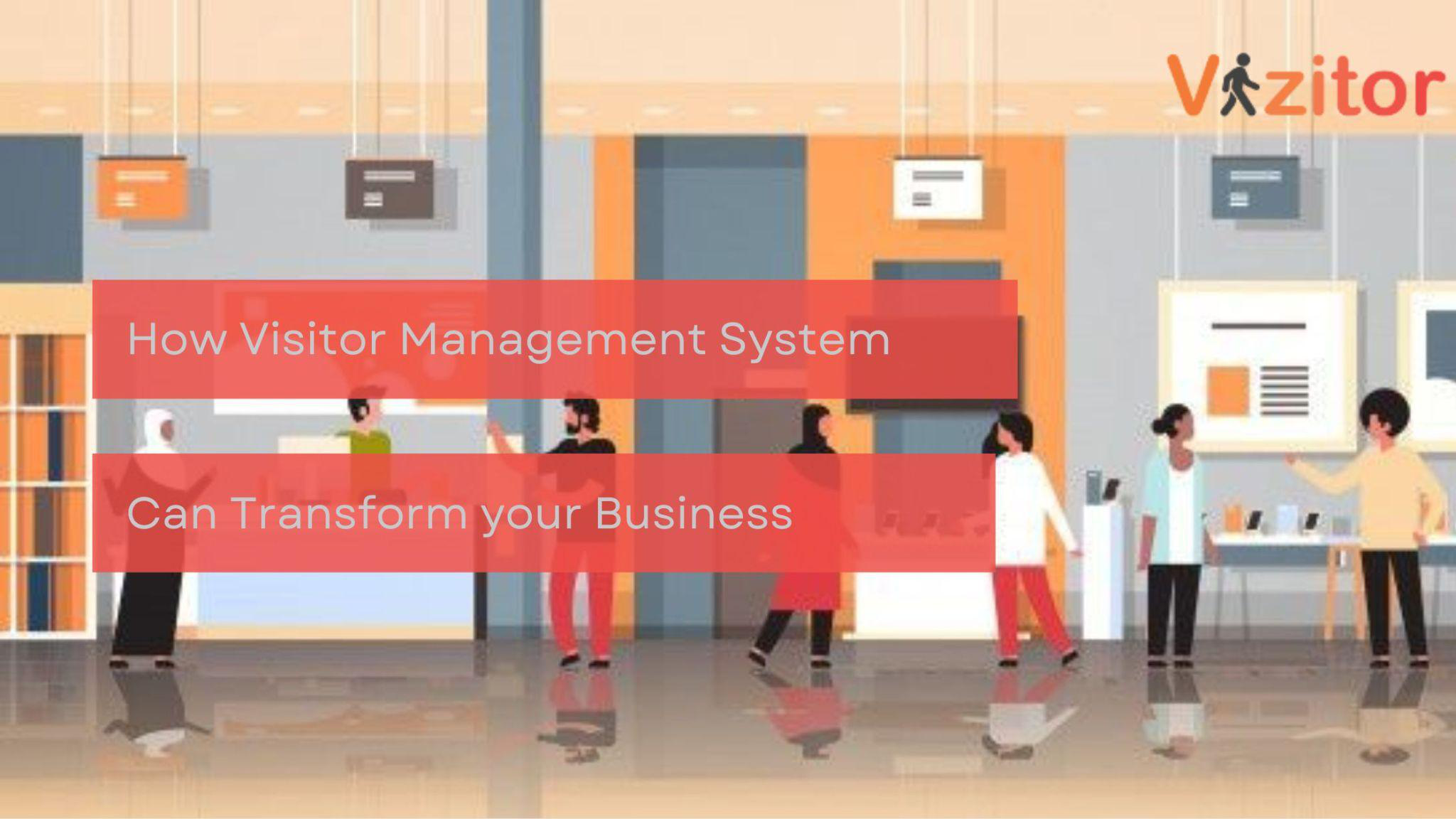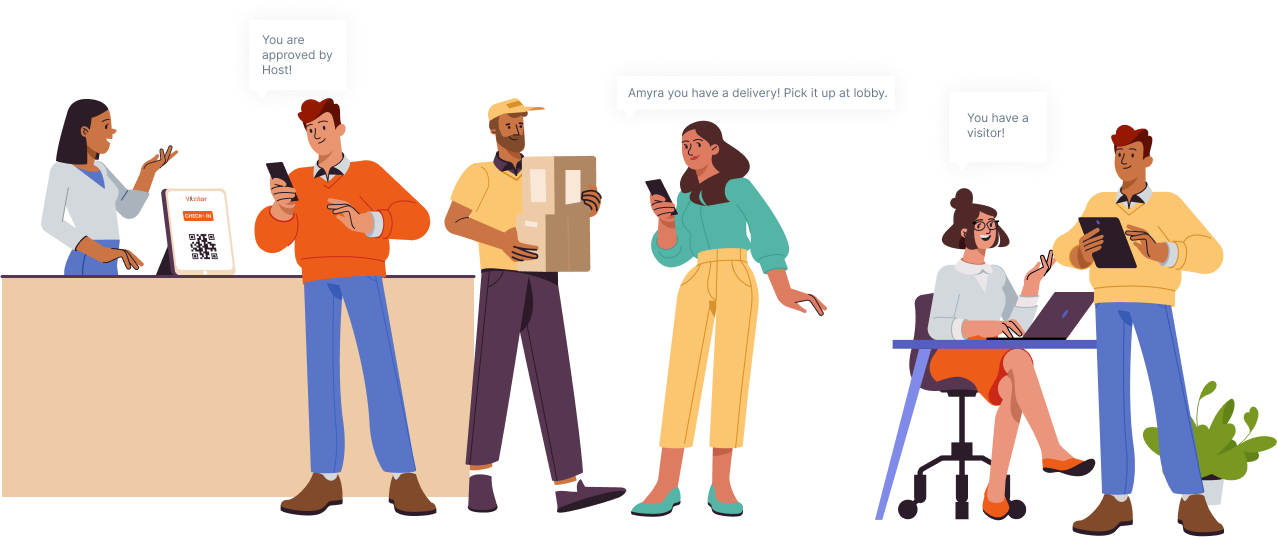Table of Content
Try Vizitor for Free!

Thu, Oct 1, 2020
Read in 8 minutes
Introduction
Did you know? Businesses that don’t use Visitor Management Systems (VMS) face many problems. For example, in a busy office where visitors come for meetings or interviews, things can get chaotic without a proper system. Imagine losing visitor information, letting people into restricted areas by mistake, or needing stronger security. These issues mess up daily work and put important data and safety at risk.
A good Visitor Management System can make a big difference for your business. First, it makes things safer by keeping accurate records of visitors and giving them special access cards, so only the right people get into certain places. Second, it makes things faster and smoother by automating check-ins, cutting down wait times, and making visitors’ experience better. Third, it lets you keep an eye on what visitors are doing in real time, so you can act fast if something goes wrong.
In short, a good Visitor Management System isn’t just a helpful tool—it’s a smart investment that protects your business, makes it run better, and shows you’re serious about professionalism. To learn more about why a digital visitor management system is so important and how it can improve your business, check out our detailed blog below.
How Has Visitor Management System Changed The Entire Business World?
The use of Visitor Management Systems (VMS) has brought significant changes to the business world:
Enhanced Security
VMS has revolutionized how businesses approach security. By accurately tracking and managing visitor access, companies can prevent unauthorized entry, reduce security breaches, and safeguard sensitive information.
Improved Efficiency
With automated check-in processes and streamlined visitor registration, VMS has boosted operational efficiency. This saves time for both visitors and employees, leading to smoother workflows and enhanced productivity.
Better Visitor Experience
VMS has transformed the visitor experience by eliminating long wait times, simplifying check-in procedures, and providing a more personalized welcome. This improves customer satisfaction and leaves a positive impression.
Real-Time Monitoring
Modern VMS solutions offer real-time monitoring of visitor activities, allowing businesses to respond promptly to any security incidents or emergencies. This proactive approach enhances overall safety and risk management.
Data Insights
VMS generates valuable data insights about visitor patterns, peak hours, and frequently visited areas. This data can inform decision-making, optimize resource allocation, and improve facility management strategies.
Regulatory Compliance
Many industries have strict regulatory requirements for visitor tracking and access control. VMS helps businesses stay compliant with regulations, reducing legal risks and ensuring a secure environment for all stakeholders.
Integration With Other Systems
VMS can integrate seamlessly with other business systems such as access control, CRM software, and employee databases. This integration enhances data accuracy, facilitates information sharing, and creates a more cohesive operational ecosystem.
Features Of Visitor Management System
Visitor Management Systems (VMS) typically offer a range of features designed to streamline visitor check-in processes, enhance security, and improve overall visitor experience. Here are some common features you can expect from a VMS:
Visitor Registration
Online pre-registration: Visitors can save time by entering their details online through the visitor registration system before arriving, reducing wait times during check-in.
Information capture: Captures essential information such as the purpose of the visit, company affiliation, and any special requirements to personalize the visitor experience.
Data accuracy: Ensures accurate visitor data entry, minimizing errors and enhancing security during registration.
Visitor Check-in/Check-out
Self-service kiosks: Enables visitors to check in and out independently, freeing up receptionists’ time and reducing queues at entry points.
Mobile check-in: Allows visitors to check in using their smartphones via a dedicated app, offering convenience and flexibility.
Real-time tracking: Provides real-time updates on visitor arrivals and departures, aiding in resource allocation and planning.
ID Verification
Secure access: Verifies visitor identities using government-issued IDs or biometric authentication, ensuring only authorized individuals enter the premises.
QR code scanning: Streamlines the verification process by scanning QR codes on visitor passes or mobile devices, enhancing efficiency and security.
Access Control Integration
Customized access levels: Integrates with access control systems to assign specific access permissions based on visitor categories (e.g., employees, contractors, guests).
Time-based access: Restricts visitor access to designated areas during specified time frames, enhancing security and compliance with access policies.
Badge Printing
Customizable badges: Generates visitor badges with customizable fields such as name, photo, company logo, and access restrictions for easy identification.
Visitor tracking: Facilitates visual identification of authorized visitors and helps security personnel monitor visitor movements within the premises.
Host Notifications
Instant alerts: Notifies hosts immediately upon visitor check-in, providing details such as visitor name, purpose of visit, and expected duration, ensuring a warm welcome and efficient hosting.
Communication tools: Offers communication channels (email, SMS, app notifications) for hosts to coordinate with visitors, schedule meetings, or provide additional instructions.
Blacklist Screening
Risk mitigation: Conduct background checks against blacklist databases to identify potential threats or individuals with restricted access, preventing security breaches and unauthorized entry.
Real-time alerts: Alerts security personnel and hosts when a flagged visitor attempts to check in, triggering appropriate actions based on predefined protocols.
Data Privacy Compliance
Secure storage: Stores visitor information in encrypted databases with restricted access, ensuring compliance with data protection regulations (e.g., GDPR, CCPA).
Consent Management: Obtains visitor consent for data processing and sharing, providing transparency and control over personal information usage
Reporting and Analytics
Performance metrics: Generates detailed reports on visitor traffic, peak visitation hours, popular entry points, and visitor demographics, aiding in strategic decision-making and resource optimization.
Trend analysis: Analyzes visitor behavior patterns over time to identify trends, opportunities for improvement, and areas of concern (e.g., unusual visitor activity).
Emergency Management
Emergency alerts: Sends real-time alerts during emergencies (e.g., fire, evacuation) to visitors and staff, providing evacuation instructions and ensuring safety protocols are followed.
Access control lockdown: Enables rapid lockdown of access points in emergencies, preventing unauthorized entry and controlling the flow of people for safety reasons.
Visitor Pre-Registration
Streamlined check-in: Allows hosts to pre-register visitors before their arrival, expediting the check-in process and reducing wait times at reception.
Enhanced planning: Enables hosts to plan for visitor arrivals, allocate resources effectively, and provide personalized services based on pre-registration information.
Visitor Watchlist
VIP treatment: Flags VIP guests or high-priority visitors on the watchlist, ensuring they receive special attention, personalized services, and a memorable experience.
Risk mitigation: Monitors flagged individuals closely, implements enhanced security measures, and notifies designated personnel in case of any suspicious activity or concerns
Types Of Modern Visitor Management System
Modern Visitor Management Systems (VMS) come in various types, each tailored to meet specific business needs and operational requirements. Here are some common types of modern VMS:
Cloud-Based Visitor Management Systems
Accessible from anywhere: Allows users to manage visitor data, check-ins, and reports via a web-based interface, offering flexibility and convenience.
Scalable: Easily scales with growing business needs without the need for additional hardware or infrastructure investments.
Real-time updates: Provides real-time updates and notifications on visitor arrivals, check-ins, and security alerts.
Mobile Visitor Management Apps
On-the-go management: Enables users to manage visitor registrations, check-ins, and access permissions using mobile devices such as smartphones and tablets.
QR code scanning: Allows visitors to check in using QR codes generated on their mobile devices, reducing manual data entry and improving efficiency.
Integration with other systems: Integrates seamlessly with access control systems, communication tools, and CRM software for enhanced functionality and data synchronization.
Self-Service Kiosk Visitor Management Systems
Automated check-ins: Provides self-service kiosks at entry points for visitors to check in independently, reducing wait times and enhancing efficiency.
Visitor badge printing: Generates visitor badges with relevant information such as name, photo, and access permissions for easy identification.
Customizable interfaces: Offers customizable kiosk interfaces to align with branding guidelines and provide a seamless user experience.
Integrated Visitor Management Systems
Comprehensive solution: Integrates visitor management functionalities with other business systems such as access control, CCTV surveillance, and CRM platforms.
Data synchronization: Ensures data consistency and accuracy across integrated systems, reducing duplicate entries and manual errors.
Centralized control: Provides a centralized dashboard for administrators to monitor and manage visitor activities, security incidents, and compliance requirements.
On-premise Visitor Management Systems
Local deployment: Installs VMS software on-site within the organization’s premises, offering full control over data privacy and security.
Customizable configurations: Allows customization of features, workflows, and access controls to meet specific business policies and regulatory requirements.
Offline functionality: Operates independently of internet connectivity, ensuring continuity of visitor management processes during network disruptions.
Visitor Management Systems with Facial Recognition
Biometric authentication: Utilizes facial recognition technology for fast and secure visitor authentication during check-ins.
Enhanced security: Verifies visitor identities with high accuracy, reducing the risk of unauthorized access and identity fraud.
Privacy considerations: Adheres to data privacy regulations and guidelines for biometric data collection, storage, and processing.
Wrapping It Up
In conclusion, Vizitor is unparalleled in its provision of the best Visitor Management System (VMS) solutions. Leveraging cutting-edge technology like cloud-based systems, mobile apps, and facial recognition, Vizitor offers advanced security measures and streamlined visitor management processes. Its user-friendly interfaces, whether through self-service kiosks, mobile apps, or web-based portals, ensure ease of use for both visitors and administrators, resulting in efficient operations.
Moreover, Vizitor understands the unique needs of businesses, offering customizable solutions that can be tailored to specific requirements, including branding, access controls, and integration with existing systems. Compliance with regulations and robust data privacy and security measures are top priorities for Vizitor, ensuring secure data storage, encryption, and access control.
The reporting and analytics capabilities of Vizitor provide real-time insights into visitor traffic, trends, and key metrics, empowering businesses to make informed decisions and optimize resource allocation.
Additionally, Vizitor’s dedicated support team ensures a smooth implementation process and ongoing assistance, making it the preferred choice for organizations looking to enhance operations and create a safe and welcoming environment for their visitors.










